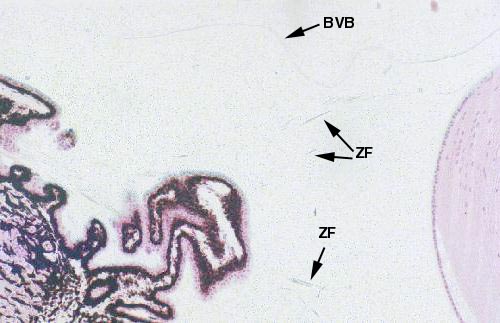 Here you see some major components of the uveal tunic: the ciliary
body and the iris. The corneoscleral tunic is at the bottom of the field; the lens at upper right.
Here you see some major components of the uveal tunic: the ciliary
body and the iris. The corneoscleral tunic is at the bottom of the field; the lens at upper right.
 Here you see some major components of the uveal tunic: the ciliary
body and the iris. The corneoscleral tunic is at the bottom of the field; the lens at upper right.
Here you see some major components of the uveal tunic: the ciliary
body and the iris. The corneoscleral tunic is at the bottom of the field; the lens at upper right.
The ciliary body is a mass of smooth muscle, from which project into the posterior chamber finger-like ciliary processes. It has both mechanical and secretory functions.
The lens is physically attached to the ciliary body by wispy (and, in this image, invisible) strands of CT, the zonule fibers. When the ciliary body contracts or relaxes, the altered tension on these fibers changes the shape of the lens to accommodate for near or distant vision. Other strands of smooth muscle in the iris act to open or close the pupil to control the amount of light striking the retina. Thus, the mechanical function of this part of the uveal tunic is accommodation, i.e., adjustment for distance. The eye is sometimes likened to a camera, but one difference is that in a camera you focus on near or far objects by moving the lens in or out. In the eye, you do it by changing the shape of the lens. this alters its focal length and adjusts the image focus so that it is sharp at the retinal plane.
The ciliary processes are the secretory portion. They're covered with a special
double-layered epithelium. They produce the fluid that fills the
posterior and anterior chambers, the aqueous humor. This will be dealt with in more detail in another portion of this exercise.

The accommodation system is set up in such a way that when
the ciliary muscle is relaxed the eye is focused at an infinite
distance; muscular effort is required for accommodation at close
distances, not long ones. The reason for this is because in terms of
normal vision, "infinity" is only a few feet away, and most animals
spend the bulk of their time observing things at "infinity." If the
ciliary muscle had to be contracted for distance accommodation,
constant eyestrain would be the inevitable result. Individuals who
spend their lives doing close work (histology professors, say, who
stare at computer keyboards and screens for long periods of time...)
often do develop eyestrain, for just this reason.
Monkey eye; H&E stain, paraffin section, 40x and 400x